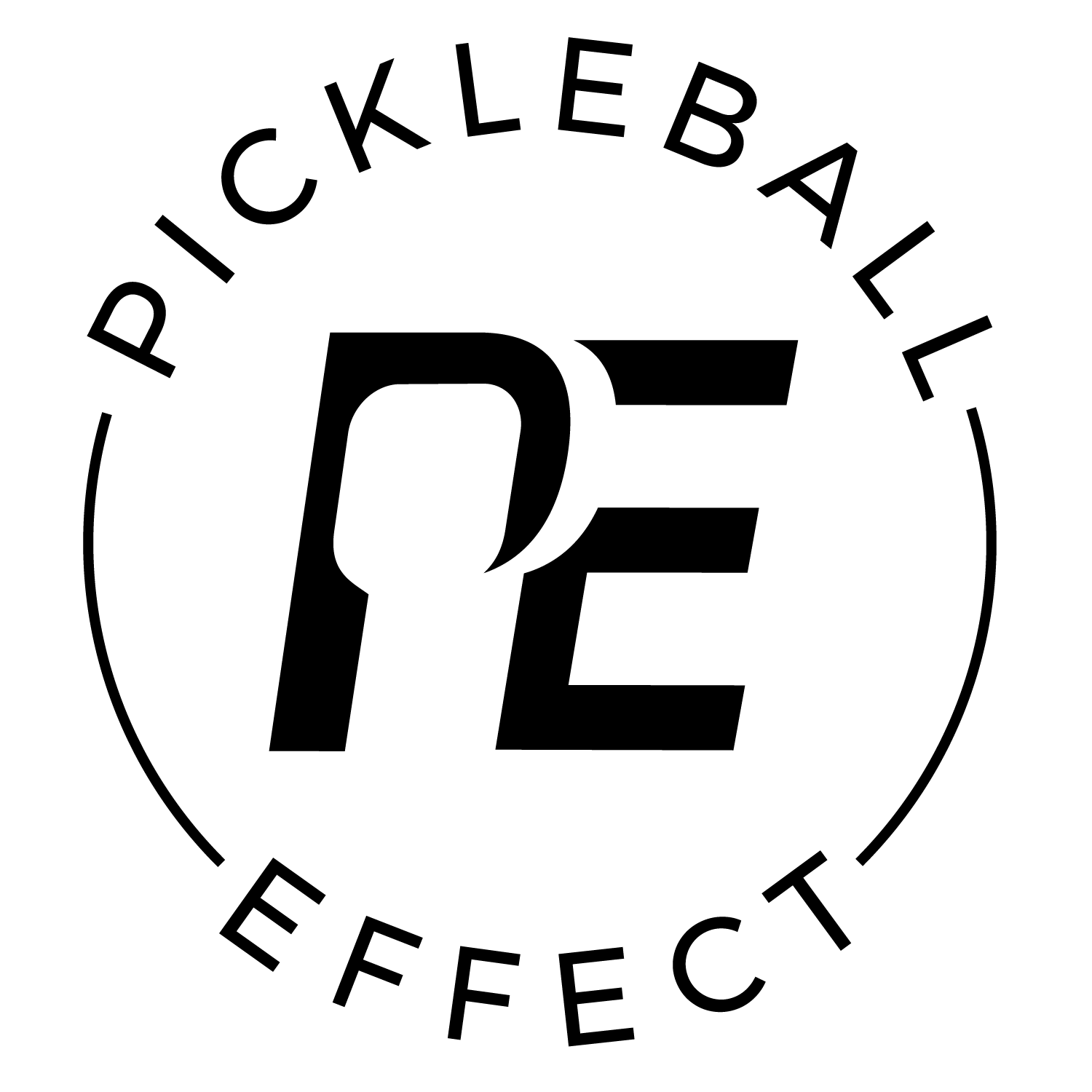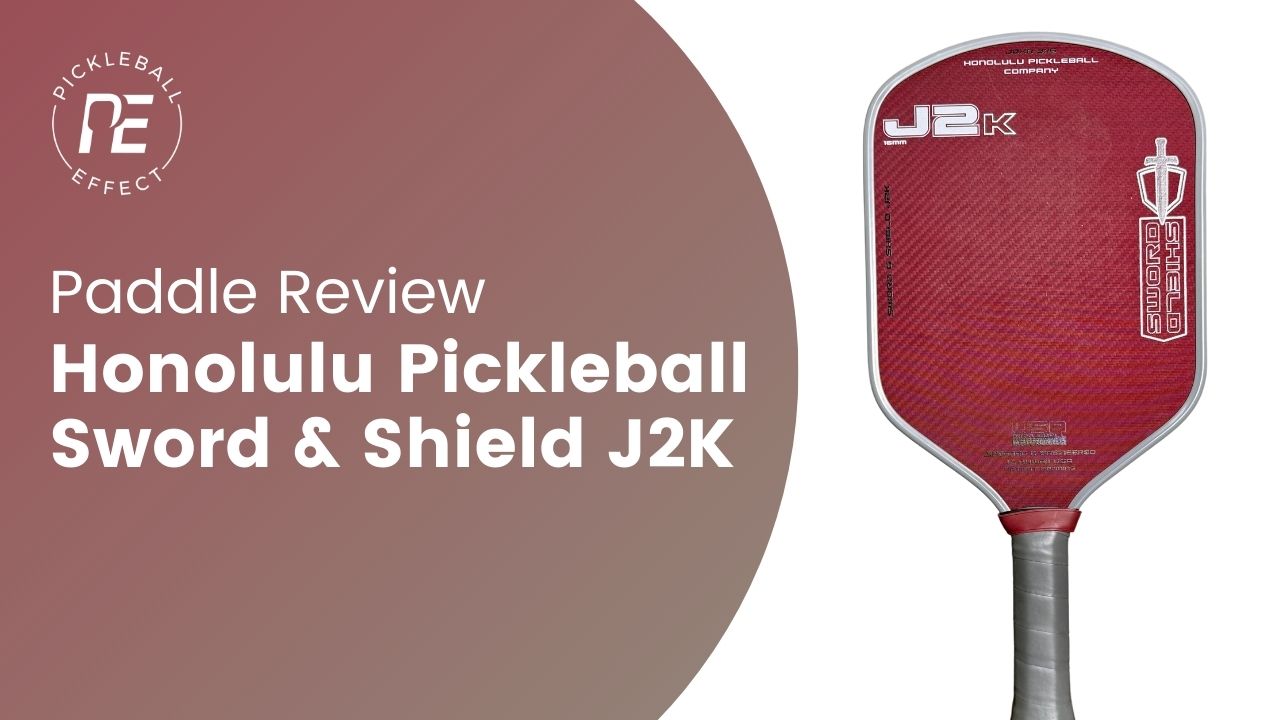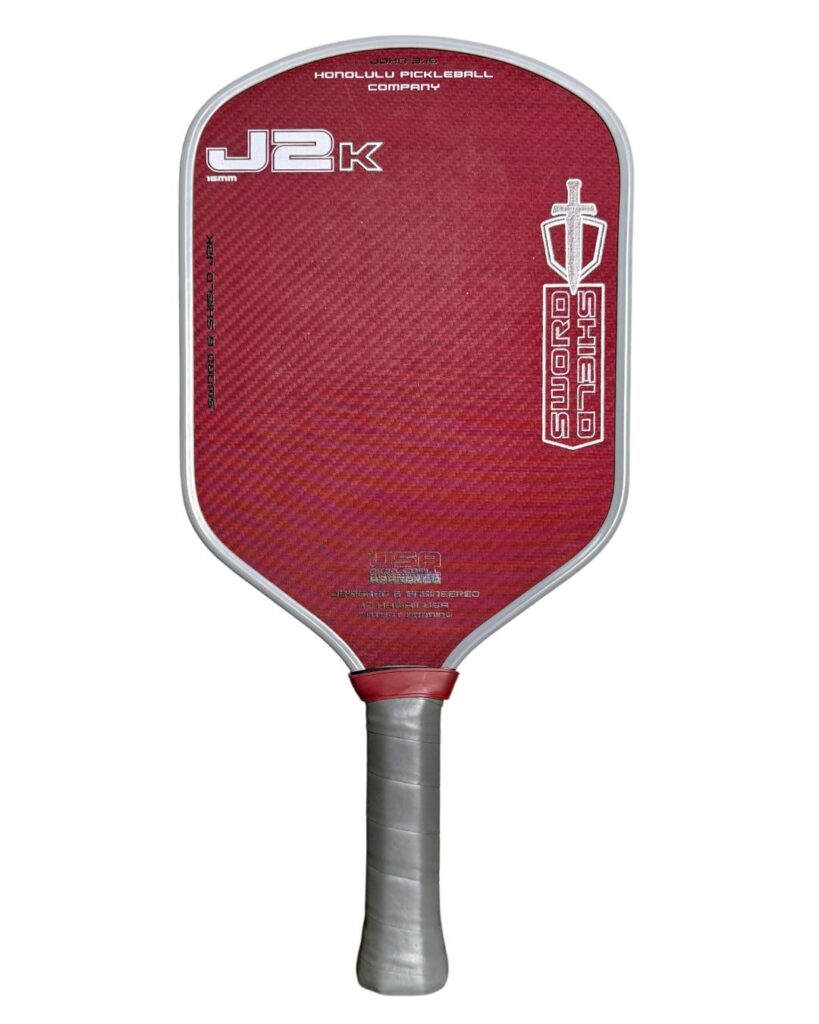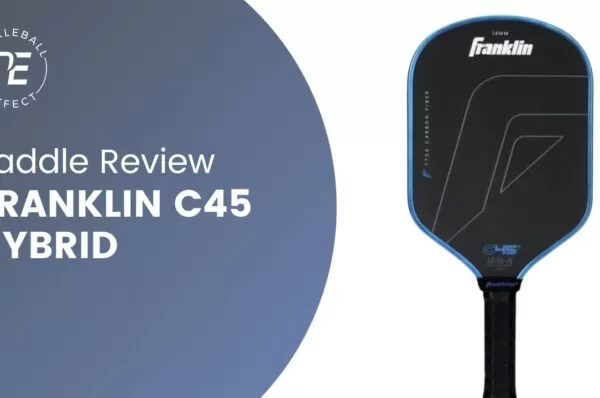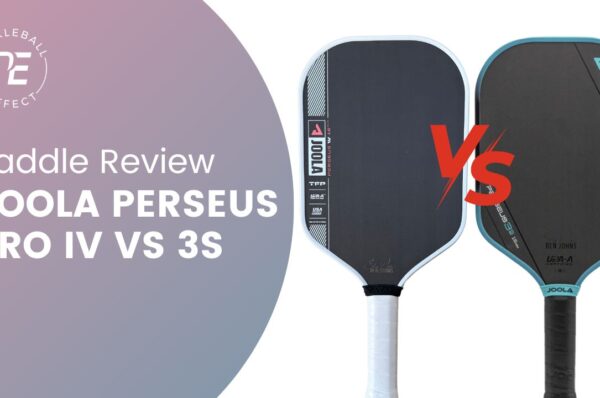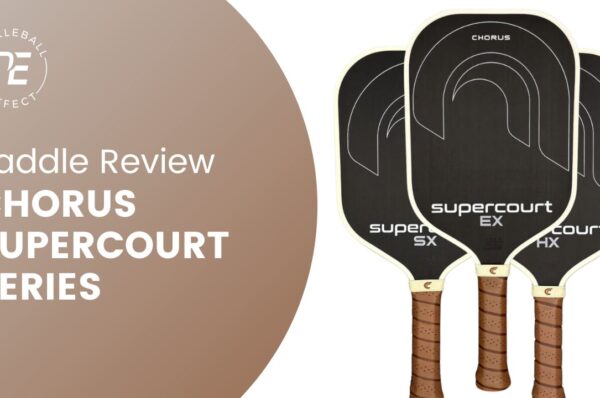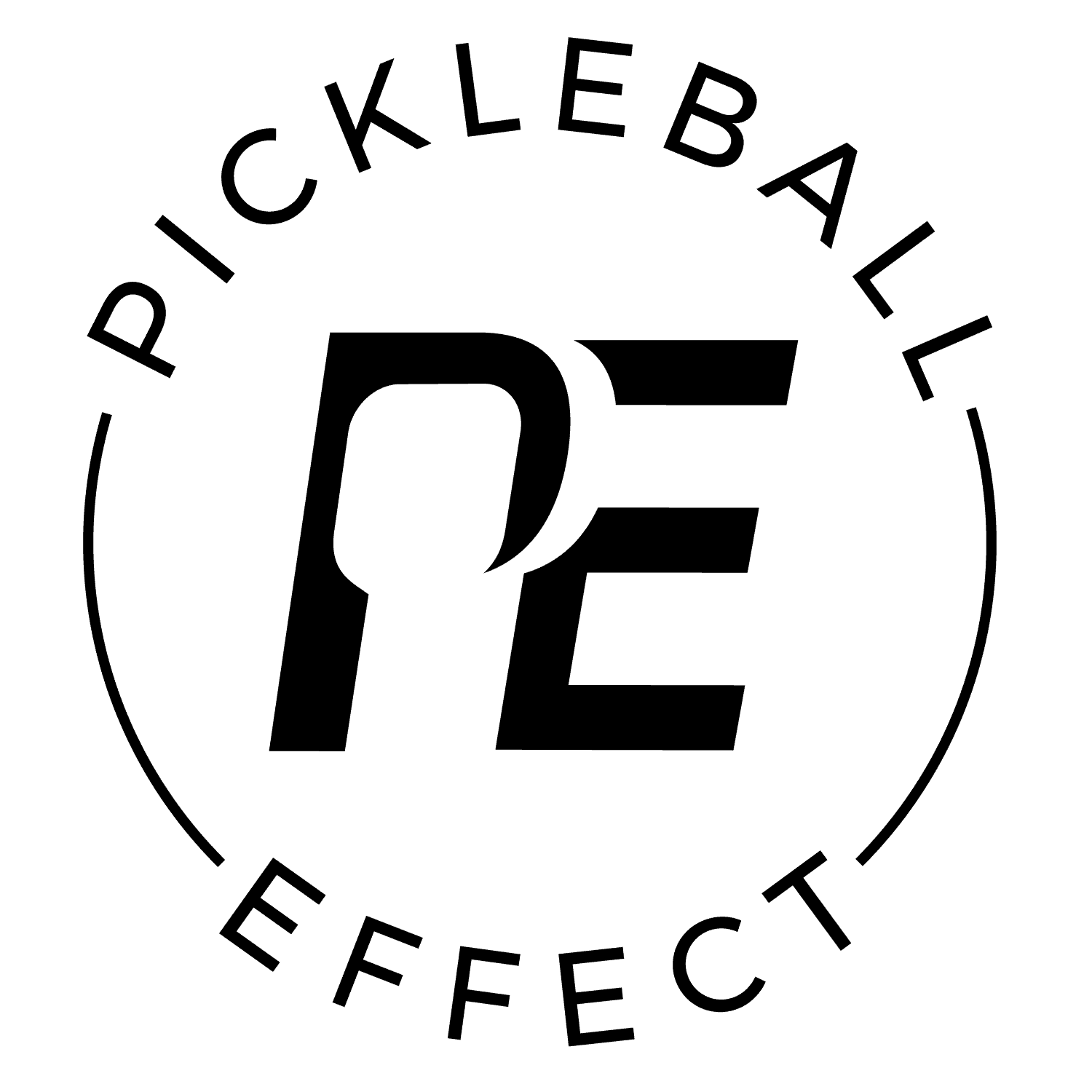Honolulu Pickleball Company is a newer brand that has been gaining attention in online forums recently. Players have been expressing positive feedback and engaging in discussions about their Sword & Shield J2K paddle. Intrigued by these comments, I decided to give it a try and it turns out that it’s a pretty good paddle.
With a hybrid shape, 16mm thickness, thermoformed design, and foam-injected walls, along with a 100% Kevlar face, the paddle’s construction may seem conventional. However, its lighter swingweight combined with its high level of forgiveness is what sets it apart and makes it one of the better all-court style paddles you can find right now.
After spending over two weeks drilling and playing with the paddle, here are my thoughts on its performance. Additionally, I have sections below my review of how the J2K compares to similar paddles and how it compares to the J2K Pro version.
Table of Contents
Paddle Stats & Tech
Sword & Shield J2K
- Static Weight: 7.9-8.2
- Swingweight: 113-115 (moderate)
- Twistweight: 6.9-7.1 (high)
- Spin RPMs: 1948 (high)
- Length x Width: 16.2″ x 7.8″ (hybrid)
- Face: 100% Kevlar
- Grip Circumference: 4.125″
- Handle Length: 5.5″
- Core: 16mm Polypropylene Honeycomb, Foam Walls
- Special Features: Thermoformed
- Paddle Type: All-court
- Price: $155 ($140 with code 10EFFECT)
- Warranty: 6 months
(Get 10% off with the discount code 10EFFECT directly on their website)
I wanted to add one comment about the head shape of the paddle. While it looks very similar in shape to the Six Zero Double Black Diamond that popularized the hybrid shape, it’s subtly different. There isn’t as much flare to it so there is more material in the bottom two corners which may account in part to why we see such a strong twistweight measurement on this paddle.
Performance Summary
Offense and Power
My power and pop tests gave the paddle a medium power rating with a slightly higher pop rating. And that’s how it plays too. The j2K has a nice combination of the usable power from the baseline but not so much where it makes it too difficult to slow the ball down and work your way to the net. Then once you get to the net you have some offensive ability to put balls away and be dangerous on counters and attacks.
There were a couple of things that stood out to me on the offensive side that I liked about the j2K. One, it has a lower launch angle compared to most other 16mm paddles which made it easier to keep drives down as well as making it easier to be aggressive on 4th shots and speed ups since you could keep the ball lower when attacking. And two, the paddle carried through the ball well for how light the swingweight was. Every ball I hit seemed to be hit a little heavier as a result. I think this is in part due to how forgiving the paddle is and its slightly higher static weight and lower swingweight combo. I liked it.
The paddle had a light enough swingweight where it moved pretty freely and doesn’t hold you back in hand battles though if you compare it to other paddles that have 115 swingweights the J2K feels a little heavier for some reason. It wasn’t a deal breaker or anything, just something that I noticed. As a result shots like backhand volleys or flicks were a little weaker and required more effort to accelerate through the ball compared to other paddles with a similar swingweight number.
Spin production was good. My spin tests averaged 1948 RPMs which is a strong result for me. I felt like it grabbed the ball well, my drives were dipping and I had access to spin when I needed to.
Feel and Control
The J2K has that typical stiffer, thermoformed feel to it. Compared to other kevlar paddles its impact feel is in between the Thrive AZUL and 6.0 Ruby. It’s not as stiff as the Thrive AZUL, but it’s stiffer than the 6.0 Ruby.
Though the paddle has a little stiffer feel and higher pop numbers, I was able to control the pace of play with it well. The lower launch angle of the paddle helped keep the ball down on drops and dinks despite it having decent power and good pop. Resets took a couple of play sessions to adjust but I did get comfortable with it there too. When I compared it to other all-court style paddles I didn’t feel like it was any harder to control. It does have a bit stiffer feel to it though so if you prefer softer feeling paddles then you probably wouldn’t connect with this one well. There are softer feeling all-court style paddles like the 6.0 Ruby or Mark OneX.
Forgiveness & Maneuverability
The J2K paddle’s forgiveness level is what stands out the most to me. It offers remarkable forgiveness and a sweet spot size that’s comparable to a standard or wide body-shaped paddle. So you get some extra reach with its hybrid shape paired with the forgiveness level of a standard or wide body shaped paddle.
In terms of maneuverability, despite its swingweight suggesting a light feel, I was surprised to find that it plays slightly heavier. I would consider it more of a midweight paddle, as it doesn’t move as swiftly as I anticipated based on its numbers. I think its slightly higher static weight and strong twistweight contribute to this. I wouldn’t consider it a slow paddle or anything, but I would have guessed its swingweight was closer to 116 or 117. At least for the paddle that I playtested with. It’s possible you’ll get a lighter one than me, I had one that was on the heavier side of their weight range.
My Tungsten Tape Set Up
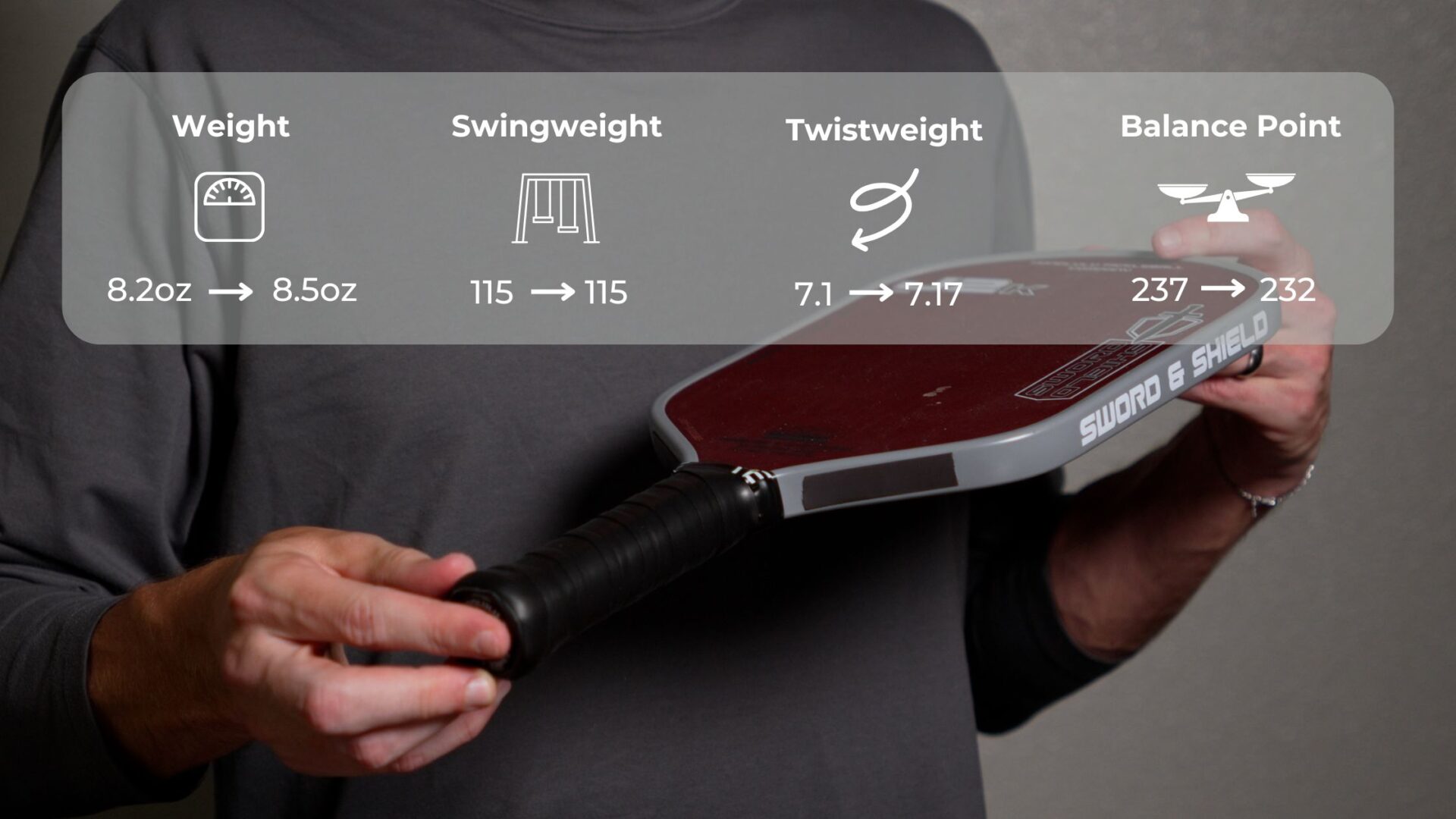
For this paddle I put two inches of 1g per inch tungsten tape on each side of the throat. My goal was to bring the balance point down so that it was easier to accelerate through backhand volleys and flicks. Adding the weight here brings that balance point down without increasing the swingweight, which is what I wanted. This location won’t help much with the twistweight and forgiveness level of the paddle but since it’s already a very forgiving paddle, this didn’t matter to me.
Comparison to Similar Paddles
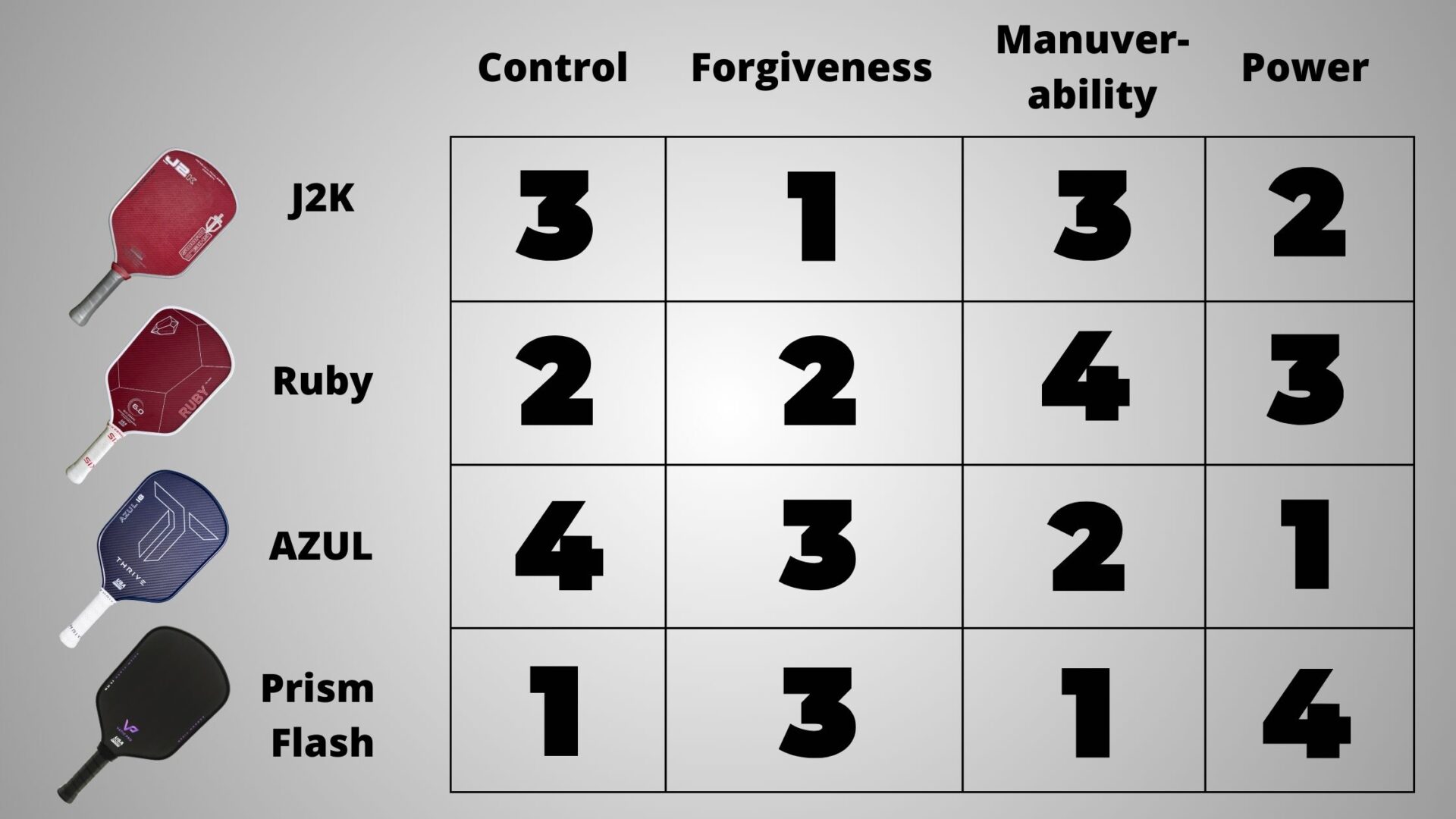
Comparing the J2K to other popular 16mm Hybrid paddles like the Six Zero Ruby, Thrive Azul, and Vatic Pro Prism Flash, here’s how I would stack them against each other. The number one represents it has the most in that category and the number 4 represents it has the least in that category. The J2k essentially falls in between the AZUL and the Ruby while the AZUL is the most power oriented and the Prism Flash is the most control oriented.
Comparison to the J2K Pro
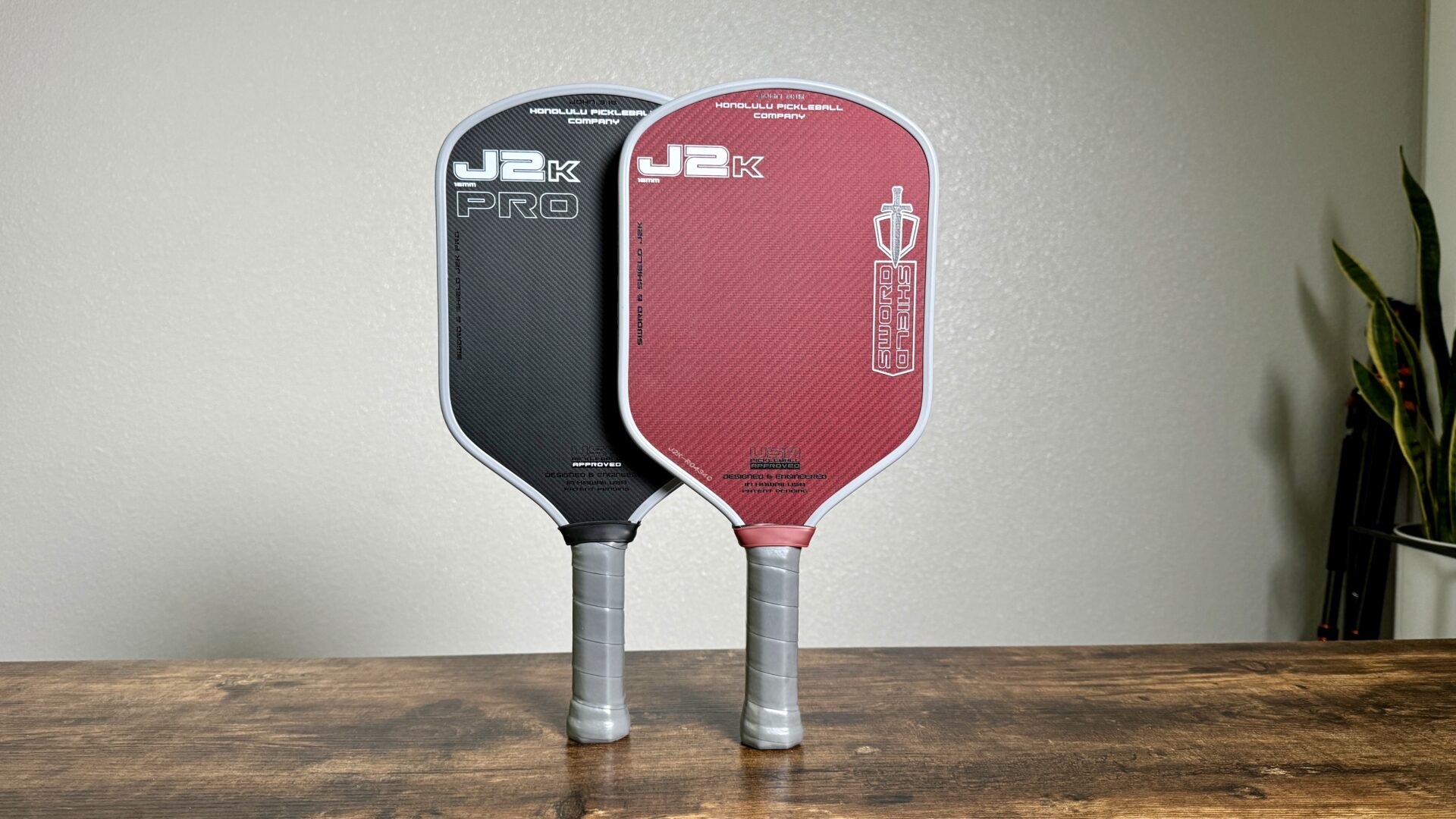
Now let’s talk about the J2K compared to the J2K Pro. As far as I understand, the only difference between the two is that the Pro version has a tighter weave in the facing layer. You can visibly see the difference between them. However, when you play them next to each other, there isn’t as much difference as Honolulu Pickleball leads you to believe. The Pro version is advertised as being more powerful and poppy but I didn’t think they played that differently. The Pro is maybe a little poppier but it wasn’t enough to change the outcome of a point. The Pro version does have a little stiffer feel to it and the one I had was lighter by about .2 ounces than my non pro J2K so it felt lighter and more maneuverable though that may just be that I got a light Pro and little heavier J2K. I’d honestly be happy playing with either version and could swap between them seamlessly. However, I preferred the slightly softer impact feel of the J2K and would pick it over the Pro version.
My Recommendation
I thought the J2K played well and had many more upsides than downsides. Price aside, this is one of my favorite all-court style paddles I’ve played so far and you should consider it if you’re on the hunt for an all-court paddle. While it may not be groundbreaking I do think it offers a couple of advantages over other hybrid all-court paddles, mainly it’s extra forgiveness, good plow through, and lower launch angle. I really enjoyed the bump in forgiveness compared to other hybrid paddles, the spin was there, it was maneuverable enough, it had a familiar feel to it and the price was good. I just wish the branding of the paddle was more attractive.
The only reasons you might not like this one is if you prefer a plusher feel in which case you’d probably like the 6.0 Ruby more or if you are a wristy player and want something that is easier to manipulate and move in which case a paddle like Bread & Butter Loco could be a good option.
(Get 10% off with the discount code 10EFFECT directly on their website.
Braydon competes at the 5.0 level and plays in 5-10 tournaments a year. He plays/drills 3 to 4 times a week and would play more if time allowed it.

Paddle Terms Glossary
We’ve categorized paddles into three categories. Control, All-Court, and Power. Paddle categories are determined by Braydon after he hits or reviews the paddle.
- Control paddles offer a softer feel and better absorbs pace off the ball but doesn’t give you as much power.
- All-Court paddles give you a blend of power and control and does well at everything though it doesn’t excel at anything.
- Power paddles often have a firmer feel and will return more power but are harder to control.
A paddle’s weight represents the inherent mass of the paddle as measured on a scale. However, relying solely on this static weight measurement can be misleading when assessing the true perceived heaviness of the paddle. Even if two paddles both clock in at 8 oz, their actual heft in your hand can markedly differ due to variations in weight distribution within the paddle. This is why the static weight should be considered with the swingweight of the paddle. See the definition of swingweight below.
The weight value listed in the database corresponds to the paddle’s weight that I used to gather the swingweight and twistweight measurement. It’s possible that if your paddle has a different static weight than then the swingweight and twistweight may be slightly different.
There are three primary shapes a paddle can have which consists of the length and width of the paddle. These three shapes are:
- Elongated: The dimensions for an elongated paddle are 16.5″ x 7.5″.
- Standard: A standard shaped paddle has dimensions of 16″ x 8″.
- Hybrid: A hybrid shaped paddle falls somewhere in between the standard and elongated shapes, with approximate dimensions of 16.25″ x 7.5″-7.7″.
Then there are two less common shapes you’ll see. These are:
- Extra-Elongated: This shape is 17″ x 7″
- Widebody: This any paddle shorter than 16″ long.
When considering the advantages and trade-offs of paddle shapes, it’s important to understand the characteristics of each shape.
- Elongated Paddle: An elongated paddle offers increased reach, spin, and power. However, this additional reach comes at the expense of forgiveness, particularly from side-to-side.
- Standard Paddle: In contrast, a standard-shaped paddle provides less reach and a little less power & spin but offers greater overall forgiveness. This means that while you may not have the same extended reach as an elongated paddle, you gain better control and stability.
- Hybrid Paddle: The hybrid shape serves as a middle ground between the elongated and standard shapes. It provides a balance between reach and forgiveness, offering players a versatile option that combines aspects of both shapes.
It’s interesting to note that advanced players often prefer elongated shapes. On the other hand, players at lower skill levels typically opt for the extra forgiveness offered by standard shaped paddles.
Ultimately, the choice of paddle shape depends on an individual’s playing style, preferences, and skill level. Whether your focus is on reach or forgiveness, understanding the unique benefits and trade-offs of each shape can assist you in selecting the paddle that best suits your game.
Swingweight is a measure of the paddle’s resistance to swinging about the end of the handle. The higher the swingweight number the heavier it will feel in your hands. A higher swingweight has more power but is harder to swing, lower swingweight is easier to swing but has less power. Sometimes a faster swing with a lower swingweight can make up for power lost in swingweight. The price paid for that is greater impact shock. Stock swingweights will vary between 100 – 140.
Twistweight is the resistance to rotating around the long axis through the middle of the paddle from butt to tip. The higher the twistweight the more resistance the paddle has to rotating on off center hits. This measurement is closely related to the amount of forgiveness or the size of the sweet spot of the paddle. A higher twistweight indicates a bigger sweet spot. Twistweight numbers range from 5 – 8.
Measuring the revolutions per minute (RPMs) off of a serve you get a number that shows the spin potential of a paddle. Using these RPM measurements I’ve created five buckets that a paddle will fall into indicating its overall spin potential. The five buckets are:
1900 or Higher = Very High
1700 – 1900 = High
1500 – 1700 = Medium
1300 – 1500 = Low
1300 or less = Very Low
You can tell a big difference in the amount of spin a paddle generates when you compare a Very High paddle to a low paddle. But the gains from Medium to High to Very High are marginal. We’ve found that having at least a medium rating is often enough if you’re looking for a good spin paddle. However, if you’re a big hitter then you will benefit more from a high spin paddle to help you keep the ball in play more often.
The power level of a paddle is shown in miles per hour (MPH) after taking ten measurements with a speed gun of hitting a serve as hard as I can. This measurement gives you an idea of how hard you can hit the ball when given the chance to take a full swing. So shots like serves, drives and overheads. The higher the MPH reading the more power you can generate with the paddle.
I also show the percentile ranking of the measurement to give you an idea of how it stacks up against the rest of the paddles in my database.
The pop level of a paddle is shown in miles per hour (MPH) after taking the average of ten speed gun measurements of hitting a punch volley as hard as I can. This measurement gives you an idea of how hard you can hit the ball on shorter swings and gives you an idea of how quickly a ball comes off the face when you apply less force on the ball. So shots volleys, dinks, counters, and resets are all affected by the pop measurement. The higher the pop measurement the stronger your counters will be but it takes more skill to keep the ball from floating or popping up on you when resetting a hard hit ball or when dinking.
I also show the percentile ranking of the measurement to give you an idea of how it stacks up against the rest of the paddles in my database.
